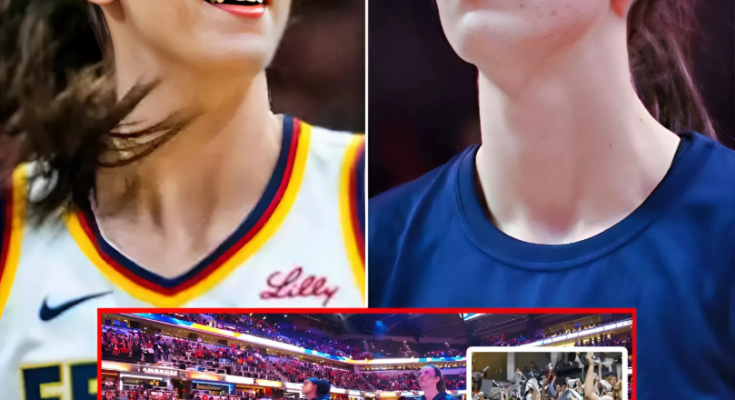SHE DIDN’T MOVE — EVEN WHEN HER TEAMMATES DID.
What Caitlin Clark and the Indiana Fever did during the national anthem froze the arena — and the aftermath is still unfolding across the league.
It was supposed to be just another night. Another packed house in Indiana. Another pregame ceremony. Another anthem.
But this time, something shifted — not in the music, not in the crowd, but in the silence between them.
As the anthem began to rise, the camera panned wide. Players lined up shoulder to shoulder. Some turned. Some lowered their heads. Some did what they always do. But one player didn’t move.
Caitlin Clark stood still. Eyes forward. Hands behind her back. Not flinching. Not folding. Not even when the teammates beside her turned their backs.
She didn’t glance. She didn’t follow. She didn’t step.
The anthem kept playing.
She kept standing.
And when the final note hit, she was still facing forward. Alone. Unmoving. Unshaken.
No one clapped.
The arena didn’t cheer. It split.
The moment — all of five seconds long — was caught by a wide-angle lens and posted by a fan in section 116. It had no caption. It didn’t need one. It spread like oxygen hitting flame. By the time the Fever tipped off against the Phoenix Mercury, the footage had already passed a million views.
By the time Caitlin checked out in the second quarter, it had been clipped, reposted, and reframed on every platform in America.
“Only one player didn’t move.”
“She faced forward. Everyone else turned away.”
“She didn’t blink — even when the anthem did.”
The headlines weren’t about the game. They weren’t about her 28 points, her 9 assists, her late fourth-quarter dagger three from the logo.
They were about that moment. That freeze. That refusal.
But was it a protest? Was it a reaction? Was it just… nothing?
No one knew. Because Caitlin didn’t say a word.
Not after the game. Not in the post-presser. Not online. No tweet. No Instagram story. No hashtag. Nothing.
She showed up. She played. She won. And she left.
But the rest of the league couldn’t. Social media was on fire. ESPN analysts were split. One called it “a quiet kind of leadership.” Another called it “a careless kind of defiance.”
The clip began getting slowed down. Enhanced. Zoomed. Commentators started dissecting frame-by-frame her expression, her breathing, even the angle of her stance. It became the most-viewed WNBA video of the season in under 24 hours.
The Fever issued no official statement. Neither did the league.
A WNBA insider told a reporter anonymously: “We’ve never had to write protocol around someone standing still. That’s the power of it. She didn’t do anything — and now everyone has something to say.”
Nike didn’t issue a comment. But they didn’t pull her ads either.
In fact, someone noticed Caitlin’s banner on the Nike homepage moved from second to lead.
That night, during the halftime report, footage emerged from another angle. A courtside fan had recorded the pre-anthem huddle. Clark could be seen whispering something to NaLyssa Smith. Smith nodded. Then turned away when the anthem started.
Caitlin didn’t.
What did she say?
Why did NaLyssa nod?
Did they plan it? Or did she decide in that moment?
The questions outpaced the answers — because there were none.
And Caitlin stayed silent.
Across the league, reactions poured in. Some praised her for “holding her ground.” Others criticized her for “standing alone instead of standing with.”
Some said it was brave.
Others said it was selfish.
But none of them said it didn’t matter.
Because it clearly did.
The crowd in the next game didn’t cheer when she was introduced. They didn’t boo either.
They watched. Like waiting for someone to break the silence first. But she never did.
By the third game after the anthem moment, it was official: every broadcast was now showing the national anthem live. The camera found her. Every time. And every time — she didn’t move.
Her teammates varied. Some stood forward. Some turned. Some glanced over at her. But she never changed.
Same stance. Same direction. Same stillness.
And yet, she hadn’t said a single word.
In a press conference five days later, a reporter asked directly, “Do you feel pressure to explain what happened during the anthem?”
Caitlin smiled, leaned into the mic, and said, “Not really.”
Then waited for the next question.
No elaboration. No headline quote. No soundbite.
Just a smile. And silence.
Meanwhile, the Fever were winning. Her stats were peaking. Attendance was climbing. But the anthem clip kept resurfacing. Reframed. Recut. Reuploaded.
One version used dramatic music and called her “The Last to Stand.” Another said, “The Stillest Protest.” Another simply captioned it: “Look Again.”
The Atlantic ran a feature titled, “Why Caitlin Clark Refuses to Move.”
She hadn’t been interviewed for it.
CNN ran a panel where three analysts tried — and failed — to agree on what the gesture meant.
The Washington Post called it “an echo of the old Colin Kaepernick moment, but inverted.”
Fox News praised her. MSNBC questioned her.
And the only person not talking was the one who made it all happen.
She still hadn’t moved. And now, the whole league was circling around the question of why.
The WNBA quietly scheduled a closed-door meeting among team representatives “to revisit anthem protocol.”
No changes were made.
But the silence coming out of that meeting was louder than most post-game conferences.
Inside the Fever locker room, teammates had different answers.
One said: “She was just locked in.”
Another: “She’s making her own statement.”
Another: “We haven’t even talked about it.”
The truth was, no one really knew what Caitlin was thinking.
And that became the story.
Because in 2025, where every athlete posts, explains, performs — she did nothing. And that changed everything.
She didn’t kneel. She didn’t raise a fist. She didn’t look down.
She didn’t even blink.
A sports radio caller said it best: “It’s not what she said. It’s what she didn’t have to.”
A mural in downtown Indianapolis went up within 72 hours. It showed a line of silhouetted players mid-anthem. And one — front and center — standing straight while others turned.
No name. No caption. Just one word: STILL.
Some say she’s making a stand.
Others say she’s staying out of it.
Maybe it’s both.
Or maybe it’s something else entirely.
Because in her silence, the crowd began to fracture. Some called her the future. Others called her the problem. Everyone called her something.
And she never said a thing.
At the next away game, the crowd erupted in both cheers and boos during anthem coverage. Broadcasters didn’t comment. They just let the noise speak for itself.
Caitlin stood in the same place. The same way. Eyes forward. No expression.
She didn’t move — even when the world around her did.
And when the anthem ended, she simply turned, walked to the bench, and waited for tip-off.
That night, she dropped 34 points.
But no one talked about the shot from the logo.
They talked about what she didn’t do before the game started.
The headlines kept coming.
And Caitlin kept doing exactly what she always does.
Nothing more. Nothing less. And never blinking.
This dramatized feature is presented as a narrative exploration based on publicly available speculation, commentary, and evolving media narratives. It does not constitute a verified news report, and no direct claims are made regarding private contractual agreements or unpublished conversations. For entertainment and cultural reflection purposes only.



